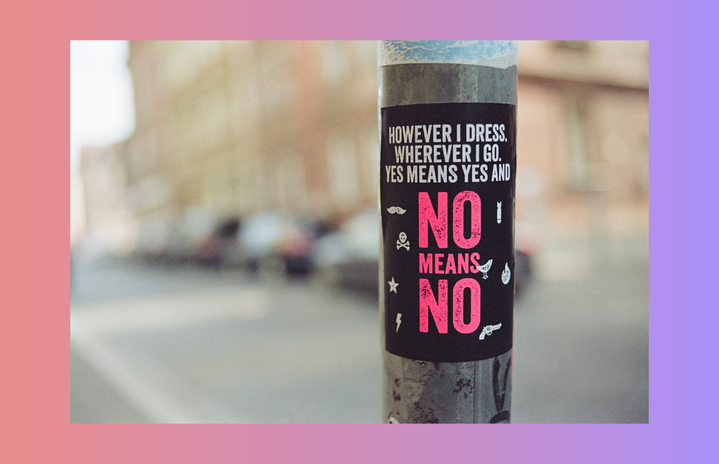Content warning: This post includes discussions of sexual assault.
One night, I went to a stoplight-themed party on my college campus — the kind where you wear green if you’re single, yellow if it’s complicated, and red if you’re taken. It was supposed to be an easy way for single people to avoid awkward questions, and for people in a relationship to make it clear that they’re unavailable. So, I was excited for this party, because I’d finally have a break from the unwanted sexual advances and disgusting comments I usually receive from men on my college campus. I thought my bright red shirt would be a clear signal for these men to back off and refrain from making unsolicited comments.
But the moment I walked into the party, a man I’d never seen before walked up to me. He leaned in for a hug and kept touching me — which I communicated that I didn’t want with my closed-off body language and the distance I made between us. Even though it was evident that I wasn’t interested in his attention, he continued to harass me throughout the night. It was at this moment when I realized that I couldn’t even attend a party, essentially wearing a sign that says “I’m taken,” without being subjected to inappropriate behavior. This man made a choice to ignore the fact that I wasn’t interested in him, contributing to the prevalence of a larger, systemic issue of misogyny, objectification, and sexual harrassment.
According to a 2019 survey conducted by Statistics Canada, 71% of students at Canadian universities reported witnessing or experiencing “unwanted sexualized behavior in a postsecondary setting,” highlighting the prevalent issue of sexual harassment among young women. While sexual harassment is a pervasive problem in today’s society, many women do not report sexual harassment or assault because they downplay what happened to them, instead belittling their experience to just “getting hit on” due to embarrassment or shame. However, there are crucial lines between flirting, getting hit on, and sexual harassment — and ultimately, we need to stop disguising sexual harassment as flirting.
Being hit on is a form of objectification.
So, what is the difference between flirting, getting hit on, and sexual harassment? According to Merriam Webster, flirting can be defined as “behav[ing] amorously without serious intent.” Flirting and getting hit on are not synonymous; Merriam Webster defines getting hit on as “[making] especially sexual overtures to,” and plenty of commenters online identify it as aggressive flirting or unwelcome advances. On the other hand, sexual harassment, according to RAINN, “includes unwelcome sexual advances, requests for sexual favors, and other verbal or physical harassment of a sexual nature.” The crucial difference between flirting and sexual harassment is that sexual harassment is unwelcome — according to Sutter Health, flirting is a mutual exchange, whereas sexual harassment is one-sided.
According to research conducted by psychologists Kimberly Fairchild and Laurie A. Rudman, often when you’re hit on, it’s often from someone you don’t know. And in my experience, getting hit on feels like being objectified — especially when I’m minding my own business. Suddenly being barraged with demands for my phone number or vulgar descriptions of my looks doesn’t feel like a warm, heartfelt compliment.
“The worst is when a man feels like he can touch you. My body is mine, and no one should be touching it unless explicitly invited to do so.”
Being hit on isn’t restricted to verbal interactions, though. “The worst is when a man feels like he can touch you,” Claire*, 22, tells Her Campus. “I’ve had my waist and butt grazed by men who thought it was no big deal. My body is mine, and no one should be touching it unless explicitly invited to do so.”
According to Everyday Feminism, what Claire has experienced at bars and clubs is a form of sexual assault that can be normalized and accepted as flirting. Any unwanted sexual advance qualifies as harassment, and if someone doesn’t receive active consent before touching you, their touch is an assault. Consent, according to RAINN, can be defined as “an agreement between participants to engage in sexual activity” that should be “clearly and freely communicated.” A lack of consent paints a clear picture of how the harasser views you — as an object for their pleasure, rather than a mutual pleasure between both parties.
It can be difficult to get a sexual harasser to leave you alone.
At the stoplight party I attended, I understood that a red shirt meant that no one should hit on me. My apparel was clearly outlined in the invitation; however, not everyone was willing to respect my boundaries.
“A lot of men at clubs are persistent in hitting on you even if you say you aren’t interested,” Claire says. “When a guy won’t leave me alone, I’ve learned to say I have a boyfriend because men respect another man’s property before they respect a woman’s decision.”
“I was walking with my friend when a man started talking to us. He wouldn’t go away. It was only when we started pretending we were dating that he finally decided to stop following us.”
Claire isn’t the only one who implements this strategy to avoid unwanted sexual advances. “I was walking with my friend when a man started talking to us,” Hailey,* 19, tells Her Campus. “He wouldn’t go away. It was only when we started pretending we were dating that he finally decided to stop following us.”
This persistence from sexual harassers can also lead to hazardous situations. “One night, I walked into my apartment building with my friends to find a group of drunk guys standing in the lobby,” Margot,* 18, tells Her Campus. “They started yelling at us, asking where we were going. We ignored them and started walking up the stairs, but they followed us. We ran into our apartment and locked the door, but the guys started banging on the door and rattling the handle. We threatened to call the cops, and they finally left.”
The risk of harassment creates barriers to women’s freedoms.
According to a survey conducted by YouGov in 2019, 50% of women feel unsafe walking alone at night, and 61% take steps to avoid being assaulted. It isn’t uncommon for women to feel unsafe in public, particularly during later hours, which means that the risk of sexual harassment creates barriers to women’s freedoms. For example, whenever my roommates want to walk alone at night, I make sure to go with them because I never want them to be vulnerable to unwanted sexual advances.
But Jenny,* 19, says that “buddying up” while walking home may not be enough. “I was walking with my friend in a dark parking lot when we were approached by two guys,” she tells Her Campus. “They kept asking for our Snapchats, but we just ignored them, thinking they’d get the hint and go away. When they kept persisting, I turned around and said, ‘What the f*ck do you want?’ They responded, ‘We just want to be your friends.’ Eventually, we gave them our Snapchats so they’d leave us alone and blocked them when we got home.” Even when paired up to feel safer at night, women still can’t prevent sexual harassment from occurring, which can leave us feeling vulnerable and scared.
Sexual harassment is a systemic issue, although it is typically negated.
The one time I confided in a male friend about how awful it is to be unsolicitedly hit on, he told me to take the compliment. I couldn’t believe how insensitive his reaction was.
“We know that the responses women receive after being harassed by friends or other supporters who the women disclose to also have an impact on how they conceptualize their experience,” Amanda Cook, Director of the Sexual Violence Prevention & Response Office (SVPRO) at the University of Waterloo, tells Her Campus. “For example, those disclosed to might say something that dismisses the interactions as ‘not a big deal,’ or they try to reframe by suggesting that ‘you should be flattered’ by the ‘attention.’ When this happens, women experiencing harassment get the message that they should minimize the harm they’ve experienced.”
“Whenever a guy won’t go away, I often blame myself and start thinking of what I could do differently to prevent it, even though it’s far from my fault.”
“Women are trained to deflect this type of attention from a young age,” Hailey says. “But whenever a guy won’t go away, I often blame myself and start thinking of what I could do differently to prevent it, even though it’s far from my fault.”
Sexual harassment is a systemic issue, and the effects on college women are substantial. “The emotional impact of sexual harassment on women attending college and university are simultaneously very individualized to those who’ve experienced the harmful comments and conduct, but also experienced at a systemic and broad-based level,” Cook says. Even those who haven’t been sexually harassed or assaulted personally often watch those close to them go through it, and live in fear of experiencing the same thing. “We know that these are not typically one-off experiences — that women experience harassment over the course of their lives, and that the impacts of these harmful interactions build up over time.”
So, what can the average student do to fight against sexual harassment?
Some college students don’t understand that being catcalled or receiving any other form of inappropriate attention is a violation of our boundaries. Even if you’ve never experienced or witnessed sexual harassment, there are still so many steps you can take to support women who have encountered this problem.
“Learn and practice bystander intervention skills to interrupt sexual harassment,” Meaghan Ross, the Sexual Violence Response Coordinator at SVPRO, tells Her Campus. “We’ve learned a lot from Hollaback’s harassment training, and there are other intersectional, trauma-informed workshops available, often by local Sexual Assault Support Centers or via offices like ours on campuses from whom folks could take a training.”
Making an effort to learn about sexual harassment — even if it’s just reading articles like this one — is a great start. “We encourage folks to learn more about how to identify sexual violence, as well as the skills needed to determine which tactic or strategy feels like a good fit for them in the moment — based on their comfort, skill and level of power in any situation where harassment is happening,” Ross says.
Additionally, it’s important to stand up and speak out whenever you see someone being sexually harassed — even if you’re not involved. Hopefully that way, harassers will get the hint that it’s wrong, victims will gain support, and sexual harassment will stop being disguised as simple, innocent flirtation.
If you’re interested in someone, what should you do instead?
So, how do you appropriately flirt with someone without sexually harassing them? Try taking a kinder, more respectful approach. Pay attention to body language. If the woman you’re interested in looks open to a conversation, you can start a friendly conversation and later ask if she’d be open to accepting your number. Do not objectify her, yell at her, or touch her without her consent. And above all else: respect her boundaries, and move on if she isn’t interested. That’s all I ask.
* Names have been changed.


